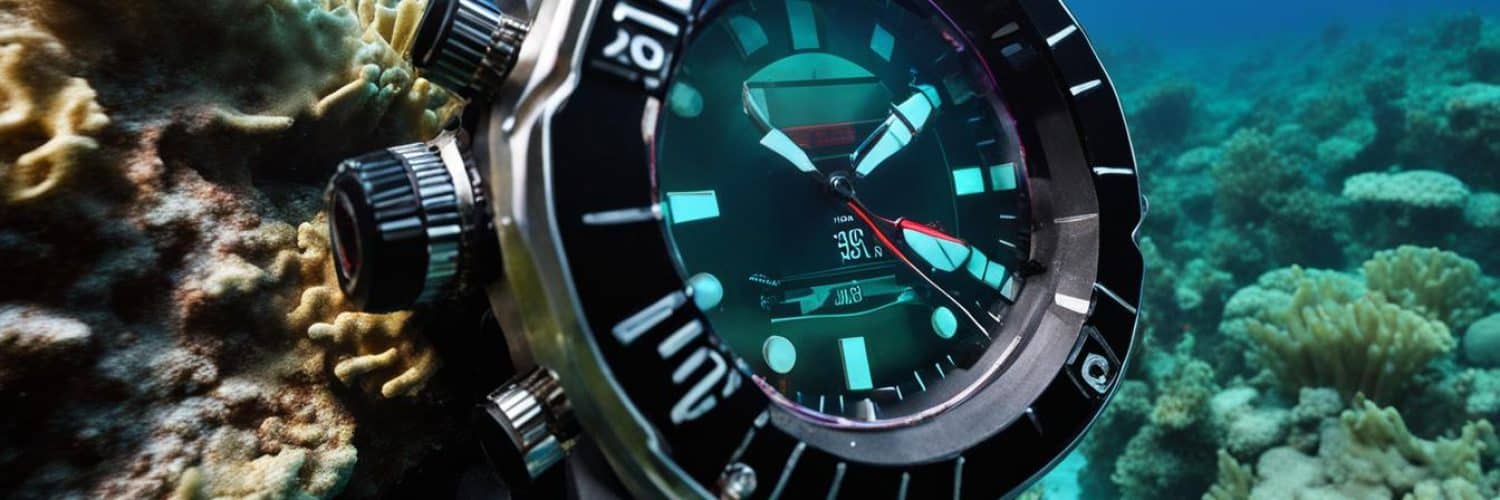Scuba diving computers are essential tools for divers, providing critical information such as depth, dive time, ascent profile, and more in real time. They come in various shapes and sizes, with different features and price ranges. In this article, we will review the best scuba diving computers available on the market, considering factors like functionality, user-friendliness, and durability. Whether you’re a beginner or an advanced diver, finding the right dive computer can greatly enhance your underwater adventures and ensure your safety.
Key Takeaways:
- Scuba diving computers provide crucial information in real time, enhancing dive safety.
- There are various dive computer options available, catering to different diving preferences and budgets.
- Consider factors like functionality, user-friendliness, and durability when choosing a dive computer.
- Beginner dive computers offer essential functionalities at affordable prices.
- Advanced and tech dive computers provide more sophisticated features for experienced and technical divers.
The Importance of Dive Computers
Dive computers play a crucial role in scuba diving safety. They provide real-time information about depth, bottom time, decompression calculations, and ascent profiles, allowing divers to make informed decisions and avoid decompression sickness.
With the ability to track crucial dive data, these devices assist divers in planning and executing safe, enjoyable dives, making them an indispensable piece of scuba gear.
Real-Time Information for Enhanced Safety
Dive computers provide divers with real-time data about their dive parameters, such as current depth, remaining dive time, and decompression status.
By continuously monitoring these factors, divers can make informed decisions to ensure they stay within safe limits and avoid dangerous conditions that could lead to decompression sickness or other diving-related injuries.
Decompression Tracking for Safe Ascent
Decompression tracking is a critical feature of dive computers that helps divers plan and execute safe ascents.
By accurately calculating the decompression stops required based on the dive profile, the computer ensures that divers ascend safely, giving their bodies enough time to eliminate excess nitrogen and prevent decompression sickness.
Digital Dive Logs for Reference and Analysis
In addition to providing real-time information during dives, dive computers also serve as digital dive logs, storing data about each dive for future reference and analysis.
By logging the dive parameters, including depth, time, and decompression stops, divers can review and analyze their diving history to identify patterns, track progress, and make informed decisions for future dives.
Tracking Crucial Dive Data
Dive computers not only provide real-time information during dives but also track crucial dive data for later analysis.
With features like dive profiles, dive time, maximum depth, and surface intervals, divers can gain insights into their diving habits and make adjustments to improve safety and performance.
Dive computers are like a diver’s personal assistant, providing vital information and ensuring a safe and enjoyable diving experience. They are undoubtedly an essential piece of scuba gear.
Key Features to Consider
When choosing a dive computer, it’s important to take into account various key features that contribute to its functionality and convenience. These features ensure that the dive computer meets your specific diving needs and enhances your underwater experience. Below are some essential features to consider:
- Dive Modes:
Dive modes determine the capabilities of the dive computer and enable you to select the appropriate mode based on your diving preferences. Some common dive modes include air, nitrox, gauge, and freedive. Whether you’re a recreational diver or an advanced technical diver, having access to the right dive mode is essential for accurate data tracking and decompression calculations. - Gas Mixes:
If you frequently dive with enriched air or nitrox, it’s crucial to choose a dive computer that supports multiple gas mixes. This feature allows you to monitor your oxygen exposure and maintain safe diving practices. Ensuring compatibility with your preferred gas mix is essential for accurate readings and decompression planning. - Battery Life and User Replaceable Battery:
Long-lasting battery life is essential for extended diving trips. Look for dive computers with a reliable battery life that lasts multiple dives without requiring frequent recharging. Additionally, consider the convenience of a user replaceable battery, which allows you to change the battery on your own, ensuring uninterrupted usage. - Air Integration:
Air integration allows wireless monitoring of your remaining air pressure directly on your dive computer. This feature eliminates the need for separate pressure gauges and offers real-time updates on your air consumption. Wireless air integration provides convenience and keeps you informed about your air supply at all times. - Built-in Compass:
A built-in compass is a valuable navigation tool for divers, enabling you to maintain your heading underwater. Having a dive computer with a built-in compass reduces the need for additional equipment and enhances your underwater navigation capabilities. - Bluetooth Connectivity:
Bluetooth connectivity enables you to connect your dive computer to smartphone apps, allowing for seamless data transfer, dive log analysis, and even firmware updates. This feature enhances the usability and versatility of your dive computer, providing convenient access to your dive data on your smartphone.
Considering these key features will help you find a dive computer that aligns with your diving preferences and ensures a safe and enjoyable diving experience. Now, let’s take a closer look at some top dive computers suitable for beginners and advanced divers.
Top Beginner Dive Computers
For beginner divers or those on a budget, there are excellent dive computers available. These beginner dive computers provide essential dive data and functionalities at affordable prices, making them ideal choices for new divers.
Mares Puck Pro Plus
The Mares Puck Pro Plus is a standout entry-level dive computer. It features a user-friendly interface, multiple dive modes, and wireless connectivity. Its intuitive design allows beginners to navigate through settings and view important dive information effortlessly.
Cressi Neon
The Cressi Neon is a stylish and versatile dive computer packed with features. Its compact design makes it suitable for divers of all sizes, and its multiple dive modes cater to different diving preferences. With its durable construction, the Cressi Neon is built to withstand the rigors of underwater exploration.
Aqua Lung i300C
The Aqua Lung i300C is a budget-friendly dive computer that doesn’t compromise on functionality. It offers advanced features like gas switching and customizable display settings, allowing divers to personalize their diving experience. With its intuitive interface, the Aqua Lung i300C is perfect for beginners seeking a reliable dive computer without breaking the bank.
These beginner dive computers provide essential dive data, intuitive interfaces, and reliable performance for new divers. Whether you choose the user-friendly Mares Puck Pro Plus, the stylish and versatile Cressi Neon, or the affordable Aqua Lung i300C, you can dive with confidence knowing that you have a reliable tool to enhance your underwater adventures.
| Mares Puck Pro Plus | Cressi Neon | Aqua Lung i300C | |
|---|---|---|---|
| Price Range | $$ | $ | $ |
| Display | High-contrast | Backlit | Backlit |
| Dive Modes | Air, Nitrox, Gauge, Freedive | Air, Nitrox, Gauge | Air, Nitrox, Gauge |
| Wireless Connectivity | Yes | No | No |
| Gas Switching | No | No | Yes |
| Customizable Display | No | No | Yes |
Table: Comparison of features for the top beginner dive computers
Top Advanced Dive Computers
Advanced divers require dive computers with more sophisticated features. These advanced dive computers cater to the needs of experienced divers, providing advanced dive planning and tracking capabilities.
Oceanic GEO 4.0
The Oceanic GEO 4.0 is an advanced dive computer that offers a dual algorithm for flexible dive planning. With a clear, easy-to-read display, divers can easily access critical information underwater. Whether you’re exploring deep wrecks or navigating complex dive sites, the Oceanic GEO 4.0 ensures accurate and reliable data to enhance your diving experience.
Garmin Descent G1 Solar
The Garmin Descent G1 Solar is a revolutionary dive computer that combines dive capabilities with smartwatch functions. With solar-powered charging, you can stay powered up for extended dive trips. Additionally, the Descent G1 Solar features fitness tracking and contactless payment options, making it a versatile companion both underwater and on land.
Suunto D5
The Suunto D5 is a versatile and user-friendly dive computer that provides advanced features in a compact design. With a backlit LED screen, divers can easily read their dive data, even in low-light conditions. The D5 also offers wireless connectivity, allowing you to share your dive logs and connect with the Suunto app for further analysis and tracking.
“With advanced dive computers like the Oceanic GEO 4.0, Garmin Descent G1 Solar, and Suunto D5, experienced divers can take their underwater adventures to the next level.”
Top Tech Dive Computers
For technical divers or those involved in multi-gas diving, specialized dive computers are essential. These advanced devices offer precise data and advanced features that cater to the demands of technical diving. Let’s take a look at three top-notch tech dive computers: Shearwater Perdix 2 Ti, Shearwater Teric, and Garmin Descent Mk2i.
Shearwater Perdix 2 Ti
The Shearwater Perdix 2 Ti is a robust and reliable dive computer designed for technical divers. It offers advanced features like multi-gas functionality, allowing divers to switch between different gas mixes during their dives. With a three-axis tilt-compensated digital compass, divers can navigate accurately underwater. The Perdix 2 Ti is known for its durability and intuitive user interface, making it a top choice for technical diving enthusiasts.
Shearwater Teric
The Shearwater Teric is a compact and stylish dive computer suitable for technical diving. It features customizable displays, allowing divers to personalize the interface based on their preferences. The Teric also offers wireless connectivity, enabling divers to easily connect to other devices and transfer data. With its sleek design and advanced functionality, the Shearwater Teric is a popular choice among technical divers.
Garmin Descent Mk2i
The Garmin Descent Mk2i is a versatile multisport dive computer that excels in technical and multi-gas diving. It supports multiple gas blends, making it suitable for divers who utilize various gas mixes during their dives. The Descent Mk2i also offers air integration, allowing divers to monitor tank pressures directly on their wrist. With its robust features and seamless integration with Garmin’s smartwatch functions, the Descent Mk2i is a top choice for technical divers seeking a multisport solution.
These top tech dive computers provide technical divers with the necessary tools and features to ensure safe and successful dives. Whether it’s multi-gas functionality, customizable displays, or air integration, these dive computers are designed to meet the specific demands of technical diving.
Dive Computers Comparison Chart
Choosing the right dive computer can be a daunting task, given the wide range of options available. To help you make an informed decision, we have created a comprehensive comparison chart of the top dive computers mentioned in this article. This chart provides valuable information about key features, including dive modes, gas mixes, battery life, and maximum depth rating. By carefully examining this overview, you can compare different dive computers and identify the one that best suits your specific diving needs and budget.
| Dive Computer | Features | Price Range | Algorithms | Gas Mixes | Battery Life | Max Depth Rating |
|---|---|---|---|---|---|---|
| Mares Puck Pro Plus | Air, Nitrox, Gauge, Freedive | $200-$300 | Multiple algorithms | Up to 3 | 200-300 hours | 120 meters |
| Cressi Neon | Air, Nitrox, Gauge, Freedive | $300-$400 | Bühlmann ZHL-16C | Up to 3 | 200-300 hours | 120 meters |
| Aqua Lung i300C | Air, Nitrox, Gauge | $400-$500 | PZ+ algorithm | Up to 3 | 100-200 hours | 100 meters |
| Oceanic GEO 4.0 | Air, Nitrox, Gauge | $500-$600 | Bühlmann ZHL-16C, Pelagic DSAT | Up to 3 | 150-250 hours | 100 meters |
| Garmin Descent G1 Solar | Air, Nitrox, Gauge, Freedive | $700-$800 | Bühlmann ZHL-16C | Up to 3 | Solar-charging | 100 meters |
| Suunto D5 | Air, Nitrox, Gauge, Freedive | $800-$900 | Suunto Fused RGBM 2 | Up to 3 | 50-80 hours | 100 meters |
| Shearwater Perdix 2 Ti | Air, Nitrox, Trimix, Gauge, Freedive | $900-$1000 | Bühlmann ZHL-16C, VPM-B | Up to 5 | 100-150 hours | 120 meters |
| Shearwater Teric | Air, Nitrox, Trimix, Gauge, Freedive | $1000-$1200 | Bühlmann ZHL-16C, VPM-B | Up to 5 | 30-50 hours | 200 meters |
| Garmin Descent Mk2i | Air, Nitrox, Trimix, Gauge, Freedive | $1200-$1500 | Bühlmann ZHL-16C | Up to 10 | 80-90 hours | 100 meters |
By referring to this dive computers comparison chart, you can easily evaluate the various models and their respective features, price ranges, algorithms, gas mixes, battery life, and maximum depth ratings. This will enable you to make a well-informed decision and choose the dive computer that aligns with your diving aspirations and requirements.
Choosing the Right Dive Computer
Selecting the right dive computer can be a daunting task, considering the numerous options available. To make an informed decision, it’s crucial to gather insights and recommendations from experienced divers. Here are some essential steps to guide you in choosing the perfect dive computer:
- Read Reviews: Before purchasing a dive computer, take the time to read reviews from reputable sources. These reviews can provide valuable information on the pros and cons of different models, helping you narrow down your options.
- Consider User Feedback: Feedback from other divers who have used a particular dive computer can offer real-world insights. Look for user feedback on online forums, dive community websites, or social media groups to understand the performance and reliability of different models.
- Personal Preferences: Your personal preferences play a significant role in selecting a dive computer. Consider factors such as design, functionality, ease of use, and budget. Determine whether you prefer a wrist-mounted computer, a console-based one, or a watch-style design.
- Safety Considerations: When it comes to safety, accuracy, reliability, and ease of use should be prioritized. Look for a dive computer that provides clear and easily understandable information, with intuitive navigation to ensure you can access critical data underwater.
“Choosing the right dive computer can greatly enhance your safety and overall diving experience.”_
Dive Computer Selection Guide
When selecting a dive computer, keep the following points in mind:
- Intended Use: Do you plan on diving recreationally or engaging in technical diving? Make sure the dive computer supports your intended diving activities.
- Dive Modes: Consider the dive modes available, such as air, nitrox, gauge, and freedive, and ensure they align with your diving preferences.
- Gas Mixes: If you dive with enriched air or Nitrox, choose a computer that allows you to monitor and manage different gas mixes.
- Battery Life: Check the battery life of the dive computer, especially if you plan on embarking on extended dive trips.
- Usability: Evaluate the user interface and ease of navigation to ensure that the dive computer is user-friendly and intuitive.
Conclusion
In conclusion, a dive computer is a crucial piece of scuba diving technology that enhances dive safety and provides essential dive data. Whether you are a beginner or an advanced diver, there is a wide range of dive computers available to suit your needs. From beginner-friendly options to advanced tech dive computers, each model offers unique features and functionalities.
By considering factors like dive modes, gas mixes, battery life, and personal preferences, you can find the best dive computer for your diving adventures. It’s important to prioritize safety and always use the most conservative computer as a backup plan. With the right dive computer, you can track your depth, dive time, decompression calculations, and ascent profiles in real time, ensuring you make informed decisions and avoid decompression sickness.
Whether you’re exploring the underwater world for recreational purposes or engaging in technical dives, a reliable dive computer will be your trusted companion. Dive safely, track your progress, and enjoy the breathtaking beauty beneath the surface. Invest in the best dive computer that suits your needs and embark on unforgettable scuba diving adventures.
FAQ
What is a scuba diving computer?
A scuba diving computer is an essential tool for divers that provides real-time information about depth, dive time, ascent profile, and more. It helps divers make informed decisions and avoid decompression sickness.
How does a dive computer enhance dive safety?
Dive computers provide real-time information about depth, bottom time, decompression calculations, and ascent profiles. This allows divers to make safe and informed decisions during their dives, reducing the risk of decompression sickness.
What key features should I consider when choosing a dive computer?
When selecting a dive computer, consider the dive modes, gas mixes, battery life, user replaceable batteries, air integration, built-in compasses, and Bluetooth connectivity.
What are some top beginner dive computers?
Some top beginner dive computers include the Mares Puck Pro Plus, Cressi Neon, and Aqua Lung i300C. These offer essential dive data and functionalities at affordable prices.
What are some top advanced dive computers?
Some top advanced dive computers include the Oceanic GEO 4.0, Garmin Descent G1 Solar, and Suunto D5. These computers offer advanced features for experienced divers.
What are some top tech dive computers for technical diving?
Some top tech dive computers for technical diving include the Shearwater Perdix 2 Ti, Shearwater Teric, and Garmin Descent Mk2i. These computers offer advanced features and precise data for complex dives.
How can I compare different dive computers?
You can use a dive computers comparison chart that includes information on key features such as dive modes, gas mixes, battery life, and maximum depth rating.
How do I choose the right dive computer?
To choose the right dive computer, read reviews, consider user feedback, and consult with experienced divers. Take into account personal preferences, design, functionality, budget, and safety considerations.







Add comment